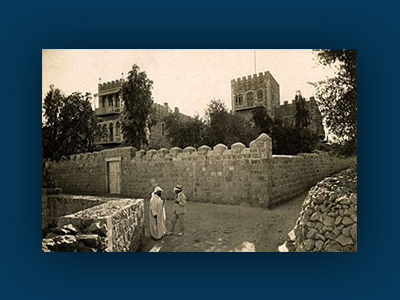
March 1, 1906
The first forty students enrolled in the newly established Bezalel School of Arts and Crafts in Jerusalem. The first students, all women, were chosen from a pool of 400 applicants and focused more on developing handicrafts than on fine arts. According to a report in the 1907 American Jewish Year Book, the school’s first students received instruction in painting, drawing and tapestry. The school’s goals in 1906 according to Bezalels’ website were, “to train the people of Jerusalem in crafts, develop original Jewish art and support Jewish artists, and to find visual expression for the much yearned-for national and spiritual independence that seeks to create a synthesis between European artistic traditions and the Jewish design traditions of the East and West, and to integrate it with the local culture of the Land of Israel.”
The idea for Bezalel originated with Boris Schatz, a Latvian born sculptor. Schatz lived in Eastern Europe before being trained in sculpture in Paris and then moving to Sofia, Bulgaria where he established an art academy. Attracted by the Zionist movement, Schatz began meeting with leaders of the movement, including Theodor Herzl, to develop support for an arts and crafts school in Jerusalem. Schatz described the meeting with Herzl thusly, “And after I had finished speaking and wondered with beating heart: What answer will he give me? ‘Good, we shall do that,’ he said quietly and resolutely. And after a brief pause he asked: ‘What name will you give to your school?’ ‘Bezalel,’ I answered, ‘after the name of the first Jewish artist who once built us a temple in the wilderness.’” (Schatz, Boris, “The Bezalel Institute,” in Israel Cohen (ed), Zionist Work in Palestine: London & Leipzig, 1911, p. 64.)
Schatz’s ideas were introduced at the Seventh Zionist Congress in Basel in the summer of 1905 where they were approved by the participants. The school focused on two ideologies in its early years, to both develop and to create a national art for the future Jewish state and at the same time to provide work for settlers in the Yishuv through the creation of handicrafts that could be sold in the marketplace. In support of the latter ideal, the Berlin based founding board of the school proclaimed, “No charity but work!” (Manor, Dalia, Art in Zion: The Genesis of Modern National Art in Jewish Palestine: London and New York, 2005, p. 11.)
The original incarnation of Bezalel would close its doors in 1929 due to financial difficulties. The photo shows the school in 1913. It would be reestablished in 1935 as the New Bezalel School of Arts and Crafts.
Correction: CIE previously listed the Bezalel opening in January 1906, but the academy has confirmed that March 1, 1906, is the correct date.
